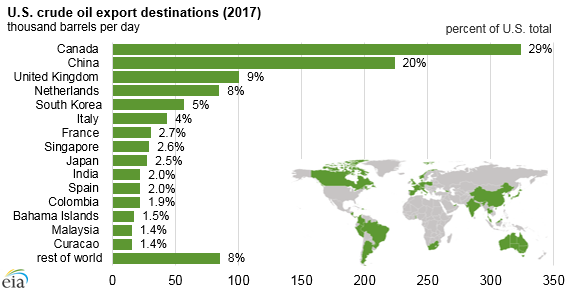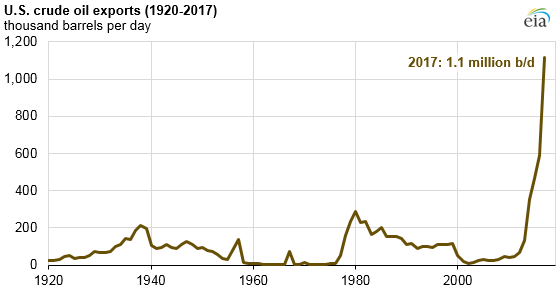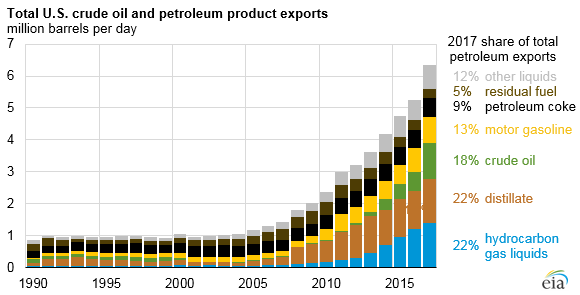China Jumps to Number Two Importer of U.S. Crude
U.S. crude oil exports in 2017 were nearly double those of 2016, and China accounted for 202,000 b/d (20 percent) of the 527,000 b/d total increase.
As a result, China surpassed the U.K. and the Netherlands to become the second-largest importing destination. However, similar to previous years, Canada remained the top destination for U.S. crude oil exports. Canada’s share of total U.S. crude oil exports continued to decrease in 2017, down from 61 percent in 2016 to 29 percent.

U.S. crude was shipped to 37 destinations, compared with 27 in 2016. Many European nations are among the largest destinations for U.S. crude oil exports, including the U.K., Netherlands, Italy, France and Spain. India, which did not receive U.S. crude oil exports in 2016, received 22,000 b/d in 2017, tying with Spain as the 10th-largest destination.

U.S. crude oil exports grew to an average of 1.1 million barrels per day (b/d) in 2017, the second full year since restrictions on crude oil exports were removed. Increased production and expanded infrastructure made it possible.
Crude oil now makes up 18 percent of total U.S. petroleum exports, making it the third-largest petroleum export after hydrocarbon gas liquids (HGL), such as propane, and distillate fuel. Before the restrictions on domestic crude oil exports were lifted in December 2015, most of the growth in U.S. petroleum exports was petroleum products - mainly HGLs, distillate fuel, and motor gasoline. Previously, crude oil’s largest share of total U.S. petroleum exports was 13 percent in 1999, when total volumes of U.S. petroleum exports were less than 1.0 million b/d, which was much lower than the 6.3 million b/d total in 2017.

Increasing U.S. crude oil production and expansions of U.S. pipeline capacity and export infrastructure facilitated increased crude oil exports. U.S. crude oil production reached 9.3 million b/d in 2017, a 0.5 million b/d increase from 2016. Several new or expanded pipelines came online in 2017 to move crude oil from producing regions, primarily the Permian basin of Texas and New Mexico, to the U.S. Gulf Coast. On the U.S. Gulf Coast, recently expanded crude oil export infrastructure in ports such as Corpus Christi and Houston, Texas, and in ports along the Mississippi River in Louisiana allowed larger volumes of crude oil exports.
A larger discount of domestic crude oil prices, represented by West Texas Intermediate (WTI) crude oil, to international crude oil prices, represented by Brent, reflects these dynamics. Spot Brent crude oil prices averaged $3.36 per barrel (b) more than WTI prices in 2017 compared with just $0.40/b more in 2016, providing a price incentive to export U.S. crude oil into the international market.
Similar production, infrastructure and price conditions will be necessary for U.S. crude oil exports to continue increasing. The Energy Information Administration’s March Short-Term Energy Outlook forecasts U.S. crude oil production to increase by 1.4 million b/d in 2018 and the Brent-WTI spread to average $3.96/b.
